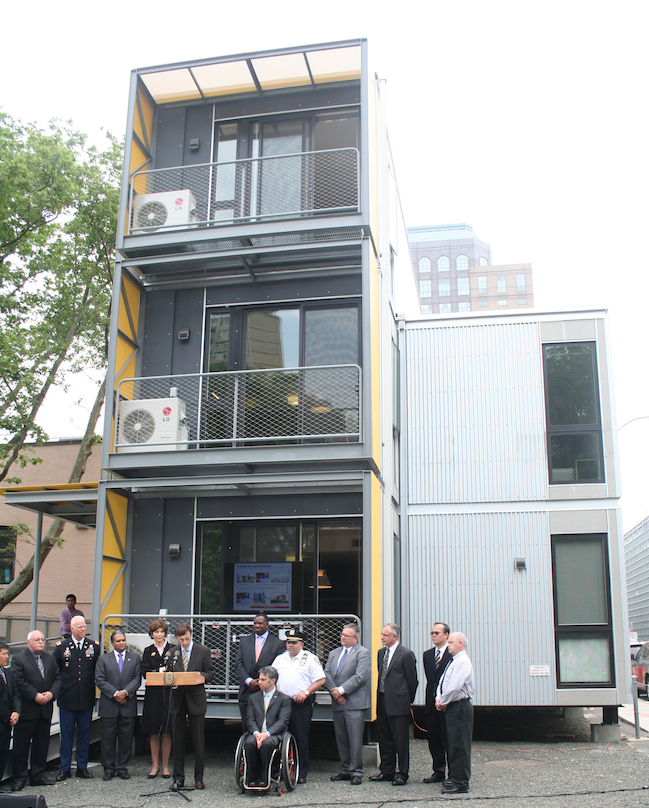
It’s nothing short of building a city within a city overnight.
That’s the fundamental premise behind a new modular post-disaster housing unit, designed by Garrison Architects, which was revealed Tuesday by New York City officials. The premise is simple but ambitious: Post-disaster housing will allow city residents to live in their neighborhood for months or years after a major disaster while their homes undergo repairs. The full-scale and operational prefabricated prototype represents the midpoint of a lengthy quest to change how cities respond to disasters in the 21st century.
The critical problem at hand is a total absence of emergency housing solutions in dense urban settings. Conventional approaches, such as the trailer homes of Hurricane Katrina infamy, are simply infeasible in major cities where space is at a premium. Therefore, the New York City’s Office of Emergency Management (OEM) partnered with Department of Design and Construction and a slew of municipal, state, and federal organizations such as FEMA and the Army Corps of Engineers, to address the issue. They first formulated a set of universal standards and specifications to govern the design of any future post-disaster urban housing in New York City. While the three steely yellow and grey units from Garrison Architects exudes industrial toughness, and is the first project built to these rigorous performance standards, it might represent only the first step in a much broader rethinking of the contemporary urban landscape.
To relocate a neighborhood within its own vacant spaces for months or years implies a potentially massive reassessment of urban infrastructure. The existing prototype’s prefabricated modules were assembled on-site in a mere 13.5 hours and, in the event of an actual disaster, city officials would aim to have all “transitional settlements” up and running after four to eight weeks of planning and prep. Diagrams provided by the city indicate they are also exploring a range of potential configurations that include off-the-grid infrastructure capabilities. However, it would stand to reason that the most vulnerable areas would have extensive planning and specialized infrastructure already in place. The ability to live in these units for extended periods is, after all, their raison d’être. This then raises the question: How will city planners create a ready-to-build city within a city? How will that plan be updated and modified as the city grows and changes?
The Pratt Institute’s Resiliency Adaptation Mitigation and Planning (RAMP) program has already collaborated with the New York City officials in exploring how units such as these could be deployed in the storm surge-vulnerable neighborhood of Red Hook. The work of a recent RAMP studio, displayed throughout the housing prototype during Tuesday’s ceremony, explored everything from placing post-disaster units on waterfront piers to infilling parks and public housing lots. The city has also released an Urban Interim Neighborhood Design “playbook” that outlines post-disaster design considerations and strategies in broad-strokes. However, for now it seems city planners will address the detailed implementation of these units only after a major disaster event.
In the mean time, the prototype sitting next to Cadman Plaza in Downtown Brooklyn will undergo a year of testing from NYU-Poly, Pratt, and intrepid city employees who will live in the units for five-day intervals. If post-disaster housing such as this is embraced by large cities, which seems likely given the proven threat of climate change, then architects and planners can expect the opportunity to reconsider how those major cities can function on an extraordinary scale.

Post a comment to this article
Report Abusive Comment